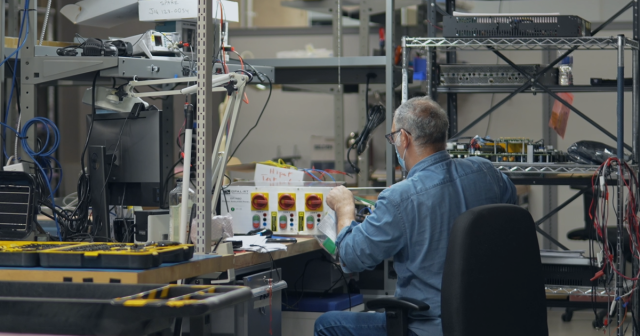
Key takeaways
- Simulation-first planning turns a high-risk interconnection into a predictable, well-rehearsed commissioning step that protects timelines and budgets.
- Grid stability simulation validates ride-through, protection, and power quality so utilities and operators share confidence in load behaviour.
- Hardware-in-the-Loop brings real controllers into the loop to reveal issues that software-only studies can miss, then confirms fixes before energization.
- Early findings from the digital twin guide equipment choices and settings, preventing costly late-stage changes.
- A proven interconnection playbook reduces uncertainty for stakeholders and supports reliable power system integration at scale.
Integrating a massive data center into a power grid is not a routine upgrade. It’s akin to adding a small power plant worth of load, and if mishandled it can shake the stability of the grid. These sprawling facilities often spring up faster than traditional grid reinforcements can be built, and their appetite for power is anything but predictable. From our perspective, this challenge is entirely solvable with the right preparation. We believe the data center and the grid should meet in a high-fidelity simulation well before any physical connection. Taking this simulation-first approach ensures that when the big switch is finally flipped, both the facility and the grid are fully prepared – no surprises, no delays.
Integrating a massive data center into a power grid is not a routine upgrade.
Massive data centers strain conventional grid planning

Large, hyperscale data centers are rewriting the rules of utility planning. A single campus can draw on the order of 100 MW or more, effectively becoming one of the largest power consumers on the grid. In fact, data centers now account for almost 80% of new large-load interconnection requests in some regions. The total power drawn by these facilities is projected to double from 17 GW in 2022 to 35 GW by 2030, an unprecedented growth rate for electricity consumption. The trouble is that these projects move at lightning speed compared to grid infrastructure upgrades. While a massive data center might be built and ready to draw power in as little as two years, adding equivalent generation capacity can take 3–5 years, and constructing new transmission lines can stretch to a decade. This mismatch creates a planning gap: utilities are being asked to connect colossal loads on timelines that outpace the traditional grid expansion cycle.
Beyond their sheer scale and quick deployment, large data centers also behave in ways that defy conventional load expectations. Unlike a factory or a residential neighborhood, a data center’s power draw can swing sharply with little warning. Banks of servers ramp up when processing intensive tasks and ease off when idle, causing steep fluctuations. Backup power systems add another twist. If the grid falters even momentarily, many data centers will disconnect and switch to on-site generators. A recent incident drove home how disruptive this can be. In one case, a routine grid fault in Virginia triggered about 60 data centers to suddenly go off-grid, dropping over 1,500 MW of load within seconds as their backup systems (uninterruptible power supplies) kicked in. Traditional planning tools never anticipated that a single customer could vanish (or appear) as a gigawatt-sized load in an instant. This unpredictability leaves operators scrambling to maintain stability. In short, utilities face a new reality. Integrating these massive, quickly arriving, and volatile loads requires a fundamentally more rigorous approach than the usual “plug and play” customer hookup.
Grid stability simulation ensures successful data center integration

Faced with these challenges, engineers are turning to real-time simulation to guarantee a smooth grid connection long before a data center ever draws live power. By creating a digital twin of the data center and its interconnection, teams can explore every failure mode and extreme condition in a virtual testbed first. This proactive testing regimen turns interconnection from a risky leap of faith into a well-rehearsed exercise. Key capabilities of grid stability simulation include:
- High-fidelity modeling: Engineers build an accurate model of the data center’s electrical systems (servers, power supplies, backup generators) alongside the utility grid infrastructure. This digital twin replicates real-world electrical behavior in detail, from steady-state power flow to fast transients.
- Extreme event stress tests: The simulator can safely impose worst-case scenarios that would be dangerous or impractical to attempt on real equipment. Sudden 50 MW load spikes, utility short-circuits, deep voltage sags – engineers can throw all of these at the model to observe how the data center and grid respond. If an instability is going to occur, you’ll see it first in the simulation lab and not during the actual grid hookup.
- Grid–facility interaction: Real-time simulation shows exactly how the grid and data center will influence each other. For instance, engineers can verify that energizing the data center’s transformers won’t cause an unacceptable dip in local voltage, and that the facility’s power-factor correction systems behave properly during grid disturbances. Joint modeling of the two systems catches issues that isolated analysis of either side might miss.
- Control and protection validation: The digital twin environment lets the team validate every control algorithm and protective relay setting under dynamic conditions. They confirm that the data center’s controls ride through minor grid flickers without overreacting, and that utility breakers and the facility’s transfer switches operate in the correct sequence for faults. Any hidden software bug or miscoordination, however rare, can be exposed early, well before commissioning.
- Iterative design refinement: Simulation provides a safe space to iterate and improve the design. If tests reveal a weakness (say, an unexpected voltage oscillation when backup generators kick in), engineers can adjust the plan by adding damping controls, tweaking settings, or upgrading equipment. They then re-run the scenario in simulation to verify the fix. This beats discovering a problem during construction or after energization, when changes are far more costly.
In essence, a simulation-first strategy lets utilities and data center developers de-risk the interconnection. Instead of guessing how a 100 MW new load will behave on the grid, you know – because you’ve already seen it play out in simulation. That confidence is invaluable. It means that by the time the real data center is ready to go live, everyone involved has proof that the integration will hold steady even under worst-case conditions.
Hardware-in-the-loop testing bridges data center and grid systems
Engineers perform a real-time hardware-in-the-loop test, integrating actual control hardware with a simulated power system. In hardware-in-the-loop (HIL) testing, actual devices like controllers and protection relays from the data center are connected to a real-time simulator. This setup creates a closed feedback loop: the simulator emulates the grid and the data center’s electrical conditions in real time, feeding voltage and current signals into the controller hardware as if it were out in the field. The controller, in turn, reacts just as it would in a live system – opening breakers, transferring to backup power, regulating voltage, and so on – and those actions feed back into the simulation. HIL testing answers a critical question: will the data center’s control systems and the grid actually work as intended?
The value of this technique is hard to overstate. Even the most detailed software model can miss quirks that only physical equipment will show. HIL brings the real control firmware, electronics, and timing into the test, so nothing is left to assumption. For example, a data center’s uninterruptible power supply might have a firmware glitch that only appears under a very specific sequence of voltage dips – a scenario too obscure to catch in pure software simulation, but one that a HIL setup could reveal as the actual UPS responds to simulated grid flickers. Likewise, a utility protective relay’s settings might need fine-tuning to avoid nuisance trips when faced with the data center’s power electronics; HIL testing will catch that, because the actual relay is in the loop seeing realistic inputs. Researchers have demonstrated that this approach can safely validate equipment performance at full power – even megawatt-scale devices – against a simulated grid with zero risk to the real grid. In practice, HIL is the bridge between simulation and reality. It allows the project team to verify that every piece of the puzzle (both software and hardware) meshes properly together.
By the end of an extensive HIL test campaign, all parties can be confident that the data center’s controls, protections, and backup systems will function correctly in unison with the grid. The process often uncovers issues that would have caused costly downtime or damage if they were only discovered during an actual grid connection. Instead, those problems get ironed out on the test bench. The result is a blueprint for integration that has been proven with the real devices in worst-case simulated conditions. When it’s time to connect the real data center, it’s not a step into the unknown – it’s a step that’s been rehearsed repeatedly with the safety net of simulation.
HIL is the bridge between simulation and reality.
Simulation-guided planning delivers confidence from design to commissioning

A simulation-guided approach touches every phase of a data center project, ensuring reliability from the earliest design stages all the way through power-on. By weaving real-time simulation and HIL testing into each step, engineers remove uncertainty and build confidence into the process.
Design phase: identifying risks early
In the design phase, the digital twin of the planned data center and grid connection serves as a proving ground for concepts. Engineers use this model to perform exhaustive studies before equipment is ordered or construction begins. They can simulate how the proposed facility will draw power under various conditions and see its impact on the local grid. If the model shows that starting a bank of servers causes an excessive voltage drop, for example, the team can specify a mitigation (such as a dedicated capacitor bank or a gentler startup sequence) while still on the drawing board. All the traditional interconnection studies – from steady-state power flow to transient stability – are enhanced by the real-time, dynamic model, which can reveal subtleties (like control interactions or harmonic distortion) that static calculations might miss. The outcome of this simulation-driven design phase is a set of plans that everyone trusts, because every major “what if” scenario has been tested on the digital twin first.
Testing and validation: rehearsing the integration
As the project moves from planning to implementation, simulation remains at the center of the strategy. During the testing phase, the focus shifts to validating hardware and fine-tuning control schemes through HIL trials. The actual control systems that will govern the data center’s power – from the facility’s energy management system to its protective relays – are connected to the simulator. Over countless test runs, engineers stage all manner of events: grid frequency dips, short outages where the data center must briefly island itself, sudden surges in IT load on a Monday morning, you name it. Each test is like a dress rehearsal for the grid connection. When a flaw is discovered (perhaps the transfer to backup power takes a few milliseconds too long, or a circuit breaker setting is too sensitive), adjustments are made and immediately verified with another simulation run. This iterative validation continues until the integrated system’s behavior is rock-solid. By the end of this phase, both utility operators and the data center’s engineers have essentially seen the full playbook of how the facility and grid will interact. There are no black boxes or unanswered questions – just a well-understood system ready for primetime.
Commissioning: smooth grid connection
Finally comes the moment of truth – commissioning the data center and putting it on the grid. Thanks to the simulation-guided preparation, this step becomes far more routine than one might expect for such a massive electrical addition. Before any live electricity flows, the team can run a final simulation of the startup sequence as a sanity check. On the scheduled day of power-on, the data center is brought online methodically, and everything behaves as predicted. The grid doesn’t wobble, protections don’t trip unexpectedly, and the facility’s own systems transition through their startup sequences without a hitch. In effect, the real commissioning is anticlimactic – and that’s a good thing. All the surprises happened in the lab months prior, when unusual behaviors were identified and resolved. With the digital twin as a guide, the actual interconnection proceeds on schedule and by the book. The new large load becomes just another part of the grid, serving its computing mission without drama, because rigorous simulation turned the unpredictable into the well-orchestrated.
OPAL-RT’s simulation-first approach to data center integration

Building on this simulation-guided planning philosophy, we approach every data center grid interconnection as a challenge that can be mastered upfront. OPAL-RT’s real-time simulation technology lets utilities and data center engineers bring the grid and the facility together virtually before any physical link is made. By creating high-fidelity models and linking real controllers in the loop, our open and scalable platforms make it possible to resolve stability, control, and protection questions long before commissioning day. In our experience, a data center and the grid should only be physically connected after they’ve been fully vetted in a virtual setting. When every stability, control, and protection kink is worked out in a no-risk scenario, the actual connection will be smooth.
For over two decades, we have helped engineering teams adopt this simulation-first strategy and de-risk their most ambitious projects. Our real-time digital simulators and hardware-in-the-loop testing solutions have been used by leading utilities, manufacturers, and research institutions to validate large-scale integrations exactly like this. The focus is always on preparation and proof. When a new data center is finally ready to pull power from the grid, our clients have already seen it all in the simulator: every surge absorbed, every controller response verified, and every contingency handled. This deep level of preparation means that when the switch is finally flipped, nothing unexpected happens – and that is the ultimate success for both the grid and the data center.
Common questions
Many practical questions arise when planning to connect a large data center to the power grid. Below, we address some of the most common inquiries to clarify the process and highlight why advanced simulation has become a go-to tool in this domain.
How do large load data centers connect to the power system?
Large data centers usually connect through high-voltage infrastructure due to their immense power requirements. A smaller facility (say under 10 MW) might tie into a local medium-voltage distribution network, but a hyperscale data center drawing tens or hundreds of megawatts often requires a direct connection to the high-voltage transmission grid. In practice, the utility will establish a dedicated substation or feeder for the data center. This substation steps down the transmission voltage (which could be 115 kV, 230 kV, or higher) to the facility’s utilization voltage (for example, 20 kV or 13 kV) and provides the necessary switching and protection equipment. The data center’s developers coordinate closely with the utility to select an interconnection point that can supply the needed capacity, and they may fund new lines or transformer upgrades as part of the project. Essentially, hooking up a large data center is more akin to connecting a new power plant or a heavy industrial facility – it involves substantial grid infrastructure and careful planning to ensure reliable service.
What is involved in interconnecting a data center to the grid?
Interconnecting a data center to the grid is a multi-step process that goes well beyond simply plugging in. First, the data center operator submits an interconnection request to the local utility or grid operator, detailing the expected load (in megawatts), operating patterns, and technical characteristics of the facility. The utility then performs a series of studies – including power flow analysis, short-circuit calculations, and stability assessments – to determine how this new load will affect the system and what grid upgrades might be required. These studies identify whether new transmission lines, additional substation capacity, or other reinforcements (like higher-capacity transformers) are needed to accommodate the data center without degrading reliability for other customers. There’s also a focus on power quality and safety: the data center may need to meet standards for voltage control, limit harmonic distortion, and have equipment like fast-acting load curtailment or on-site backup generation to manage disturbances. Once the utility and the data center agree on a plan – including who pays for the necessary upgrades – construction of the interconnection facilities (the substation, transmission tie-in, etc.) proceeds in parallel with the data center’s construction. Finally, before the center goes live, there is a commissioning stage where the interconnection is tested. In sum, interconnecting a large data center is a coordinated engineering and regulatory effort aimed at weaving a huge new load into the grid seamlessly.
Why is power system simulation important for large data centers?
Power system simulation is critically important for large data centers because of the outsized and variable impact they have on the grid. These facilities draw enormous amounts of power, and their load can change very quickly, which can lead to voltage swings or frequency deviations if not managed properly. By using simulation tools – especially real-time digital simulation – engineers can predict how the data center and the grid will behave under a wide range of scenarios. This helps identify potential problems well in advance. For example, simulations can reveal if turning on all the cooling systems at once might cause a voltage sag, or if a particular generator control setting might lead to instability during a grid fault. Just as importantly, simulation allows engineers to test extreme and unlikely scenarios (such as a sudden 100 MW load jump or an unplanned disconnect to backup power) with zero risk to actual equipment. This foresight means that by the time the data center goes live, both the operator and the utility have confidence in its behavior. Simulation essentially acts as a dress rehearsal, ensuring there are no surprises when the facility is connected to the grid for real.
What is grid stability simulation?
Grid stability simulation is the practice of modeling an electric power system’s dynamic behavior to ensure it remains stable under various conditions. When engineers talk about “stability” in the grid, they mean maintaining acceptable voltage and frequency throughout the network even when big disturbances happen – like a large generator tripping offline, a major transmission line outage, or a large load suddenly switching on or off. Through stability simulation, these events are recreated in software (or using real-time simulators) to observe how the grid responds. The simulation shows whether the grid’s frequency stays within safe limits when, say, a 200 MW load drops off suddenly, or whether voltages remain stable when a data center rapidly ramps up its consumption. If the simulated grid exhibits problems – for instance, a frequency dip below acceptable thresholds – engineers can devise solutions such as adjusting control settings, adding energy storage or extra reserves, or revising protection schemes to mitigate the issue. In essence, grid stability simulation lets utilities predict and prevent potential reliability problems. It’s especially important now that modern grids include many components that can change output or demand on short notice (like large data centers and renewable generation) – the simulation helps ensure that, despite these new challenges, the grid remains resilient and secure under all foreseeable circumstances.
The surge of large data centers does not have to be a threat to grid reliability. With careful planning and a simulation-first mindset, you can integrate these power-hungry facilities in a way that keeps the lights on for everyone. By proving out the integration in digital form – and testing the real controls in the loop – engineers turn uncertainty into certainty. The result is a win-win: data center operators get on-schedule commissioning with no unwelcome surprises, and grid operators gain a massive new customer without compromising stability. In an era of rapid technological growth, this approach ensures that our electrical infrastructure can welcome innovation without missing a beat.
EXata CPS has been specifically designed for real-time performance to allow studies of cyberattacks on power systems through the Communication Network layer of any size and connecting to any number of equipment for HIL and PHIL simulations. This is a discrete event simulation toolkit that considers all the inherent physics-based properties that will affect how the network (either wired or wireless) behaves.


